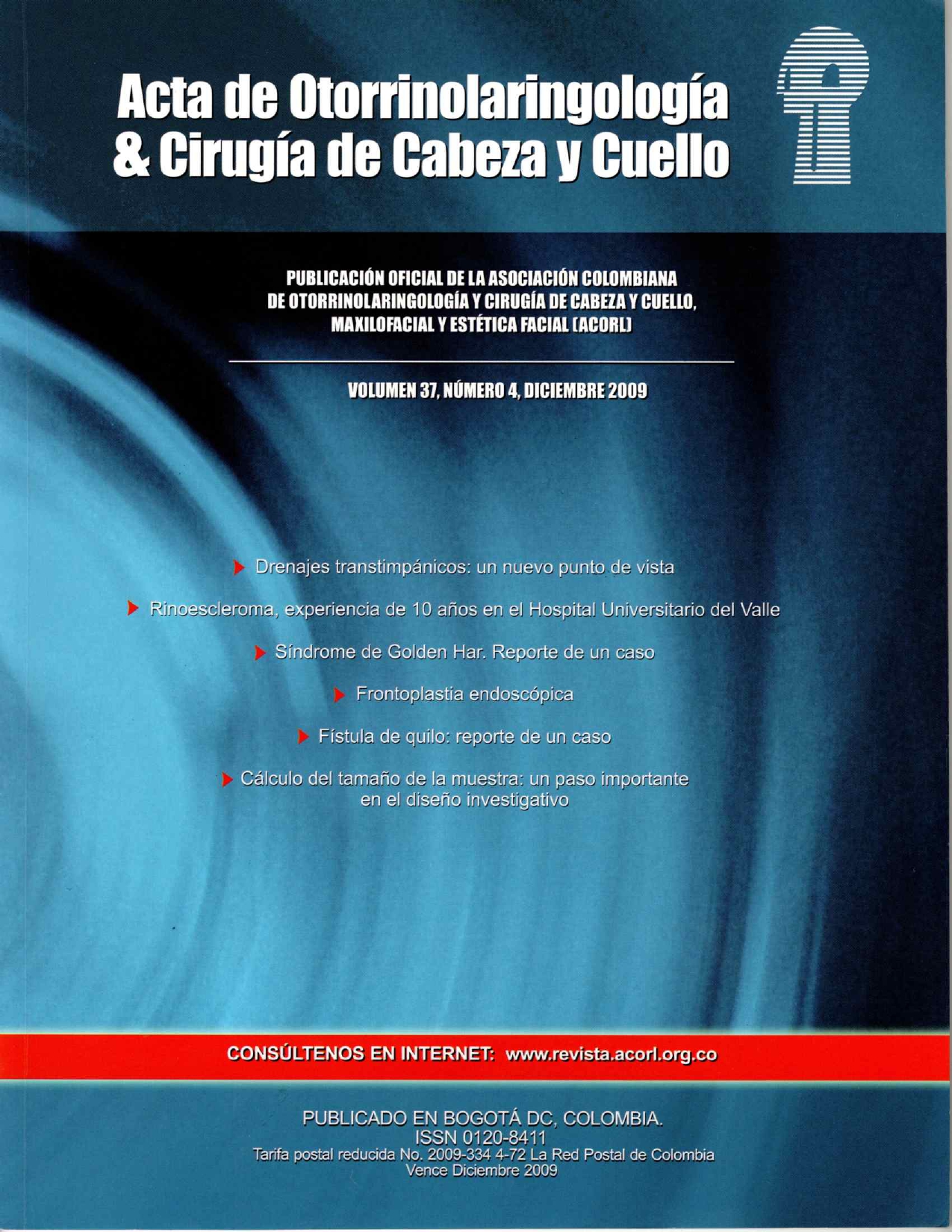Fístula de quilo: reporte de un caso
Main Article Content
Abstract
La formación de la fístula de quilo es una complicación seria después de la cirugía de cuello. Esta enfermedad puede conducir a serios problemas respiratorios, metabólicos y nutricionales. En general, la incidencia reportada está en el orden de 1 a 2,5% de los casos y de éstos un 75 a 80% ocurren en el lado izquierdo y en un 20 a 25% en el lado derecho. Cuando esta situación se presenta su manejo permanece controversial por los diferentes especialistas.
Article Details
Section

This work is licensed under a Creative Commons Attribution-ShareAlike 4.0 International License.
Este artículo es publicado por la Revista Acta de Otorrinolaringología & Cirugía de Cabeza y Cuello.
Este es un artículo de acceso abierto, distribuido bajo los términos de la LicenciaCreativeCommons Atribución-CompartirIgual 4.0 Internacional.( http://creativecommons.org/licenses/by-sa/4.0/), que permite el uso no comercial, distribución y reproducción en cualquier medio, siempre que la obra original sea debidamente citada.
eISSN: 2539-0856
ISSN: 0120-8411
How to Cite
References
1. Hehar SS, Patrick J. Bradley: Management of chyle leaks, CurrentOpinion in Otolaryngology & Head & Neck Surg 2001; 9: 120-125.
2. Loe LH. Injuries to the thoracic duct. Arch Surg 1946; 53: 448-455.
3. Myers EN, Dinerman WS. Management of Chylous fistula.Laryngoscope 1975; 85: 835-840.
4. Tilney NL, Murray JE. Chronic Thoracic duct fistula: operativetechnique and physiological effects in man. Ann Surg 1968;167: 1-8.
5. Thawley SE. Chylous fistula prevention and management.Laryngoscope 1980; 90: 522-525.
6. Shafiroff BGP, Kau QY. cannulation of the human thoraciclymph duct. Surgery 1959; 45: 814-819.
7. Van Pernis PA. Variations of the thoracic duct. Surgery 1949;26: 806-9.
8. Hollinshead WH, Rosse C. The madiastinum. In textbook ofanatomy, end 4. Philadelphia: Harper & Row, 1985; 572-573.
9. Hollinshead WH. The neck. In anatomy for surgeons: the Head& Neck, end 3. Philadelphia: JB Lippincott, 1982; 475-478.
10. Kinnaert P. Anatomical variations of the cervical portion of thethoracic duct in man. J Anat 1973; 115: 45-52.
11. Langford RJ, Daudia AT, Makins TJ. A morphological study othe thoracic duct at the jugulo-subclavian junction. JCraniomaxillofac Surg 1999; 27: 100-104.
12. Shimada K, Sato I. Morphological and histological analysis ofthe thoracic duct at the jugulo-subclavian junction in Japanesecadavers. Clin Anat 1997; 10: 163-172.
13. Barnes HA. Scalenus anticus syndrome. US Naval Bull 1945;44: 773-776.
14. Hart AKE, Greinwald JH, Shaffrey CL, et al. Thoracic ductinjury during anterior cervical discectomy: a rare complication.J Neurosurg 1998; 88: 151-154.
15. Bolger C, Walsh TN, tanner WA, et al. Chylothorax afteroesophagectomy. Br J Surg 1991; 78: 587-588.
16. Haug ES, Saether OD, Odegaard A, et al. Chylous complicationsafter abdominal aortic surgery. Int Angiol 1998; 17: 244-247.
17. Penn I. Injuries to the cervical portion of the thoracic duct. Br JSurg 1962; 50: 19-23.
18. Lampson RS. Traumatochylothorax: a review of the literatureand report of a case treated by mediastinal ligation of the thoracicduct. J Thorac Surg 1948; 17: 778-791.
19. Lapp GC, Brown DH, Gullane PJ, et al. Thoracoscopicmanagement of chylous fistulae. Am J Otolaryngol 1998; 19:257-262.
20. Rodgers GK, Johnson JT, Petrozzelli GJ, et al. Lipid and volumeanalysis of neck frainage in patients undergoing neck dissection.Am J Otolaryngol 1992; 5: 306-309.
21. de Gier HHW, Balm AJ, Bruning PF, et al.Systematic approachto the treatment of chylous leakage after neck dissection. Head& Neck 1996; 18: 347-351.
22. Kassel RN, Hava STE, Gullane PJ. The use of topical tetracyclinein the management of persistent chylous fistula. J Otolaryngol1987; 16: 174-178.
23. Hashum SA, Roholt HB, Babayan VH, et al. Treatment ofChyluria and chylothorax with medium chain triglycerides. NEngl J Med 1964; 270: 756-761.
24. Bozzetti F, Arullani A, Baticci F, et al. Management of lymphaticfistulas by total parenteral nutrition. J Parenter Enteral Nutr1982; 6: 526-527.
25. Ramos W, Faintuch J. Nutritional management of thoracic ductfitulas: a comparative study of parenteral versus enteral nutrition.J Parenter EnteralNutr 1986; 10: 519-521.
26. Nussembaum B, Liu JH, Sinard RJ. Systematic management ofchyle fistula: The southwestern experience and review of theliterature. Otolaryngol Head Neck Surg 2000; 112: 31-38.
27. Kirse DJ, Suen JY, Stem SJ, et al. Histologic effect of doxycyclinesclerotherapy on rat femoral nerve. Head Neck 1996; 18: 506-511.
28. Kirse DJ, Suen JY, Stem SJ, et al. Neurotoxic effects ofdoxycycline sclerotherapy. Otolaryngol Head Neck Surg 1998;118: 356-362.
29. Giez DB, Utrera A, Cordoncillo JM, Rada F, Carranza G. Fístuladel conducto toráxico: tratamiento médico con octeotride.Cirugía Española 2006; 79: 250-251.
30. Kent RB, Pinson TW. Thoracoscopic ligation of the thoracicduct. SurgEndosc 1993; 7: 52-53.
31. Stuart WJ. Operative injury of the thoracic duct in the neck.Edinburgh Med J 1907; 22: 301-317.
32. Blalock A, Robinson CS, Cunningham RS, et al. Experimentalstudies in lymphatic blockage. Arch Surg 1937; 34: 1049-1071.
33. Lee FC. The establishment of collateral circulation followingligation of the thoracic duct. Bull Johns Hopkins Hosp 1922;33: 21-30.
34. Canovas B, Morlan MA, Familiar C, Sastre J, Marco A, López J.Nutrición hospitalaria: Resolución de una fístula linfáticacervical con tratamiento dietético oral 2005; 6: 429-432.
35. Allen DP, Briggs CE. Wounds of the thoracic Duct occurring inthe neck: report of two cases; resume of seventeen cases. Am JMed 1969; 401-404.
36. Scott KJ, Simco E. Thoracoscopic management of cervicalthoracic duct injuries: an alternative approach. Otolaryngol HeadNeck Surg 2003; 128: 755-757.
37. Spiro JP, Spiro RH, Strong EW. The management of chylefistula. Laryngoscope 1990; 100: 771-774.
38. Lucente FE, Diktaban T, Lawson W, Biller HF. Chyle fistulamanagement. Otolaryngol Head Neck Surg 1981; 89: 575-578.





